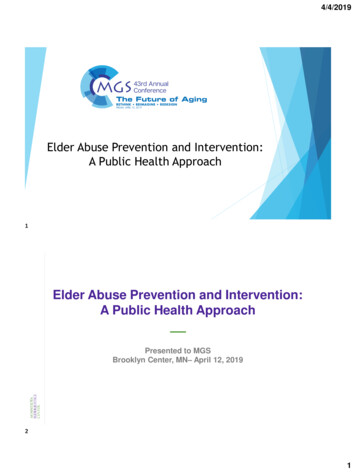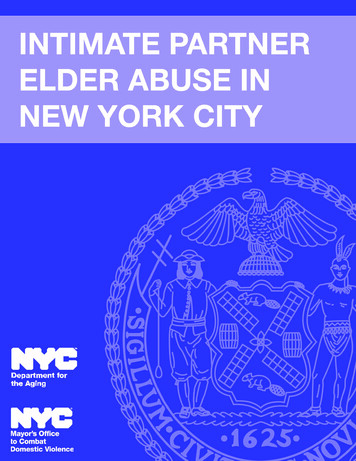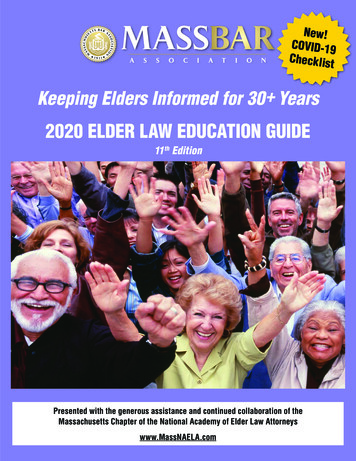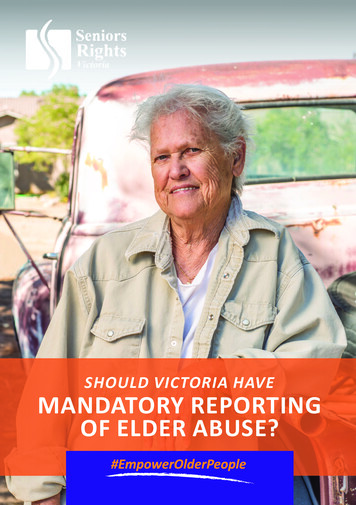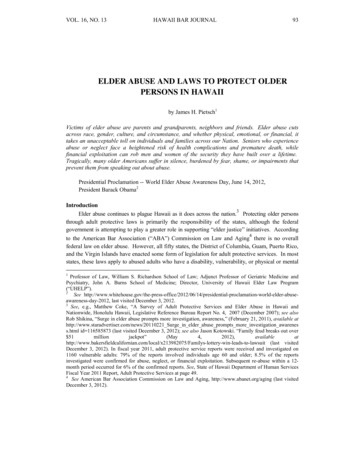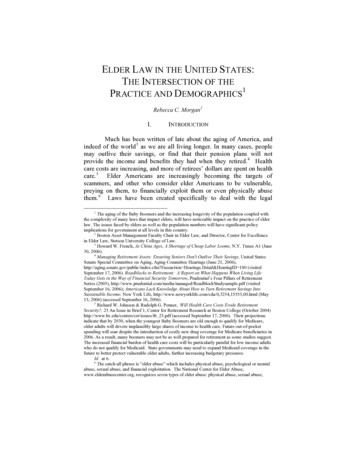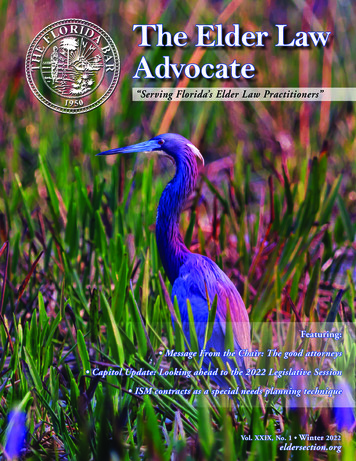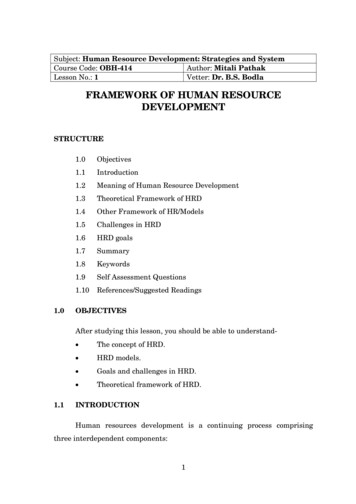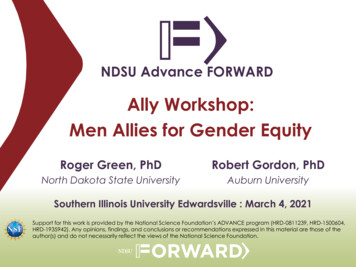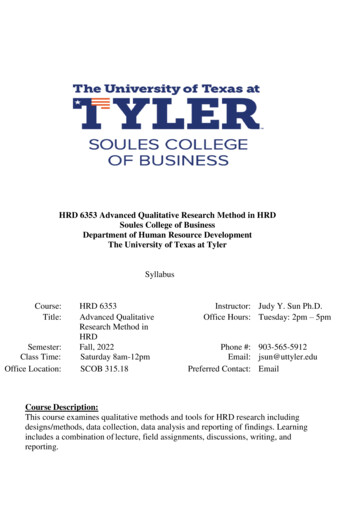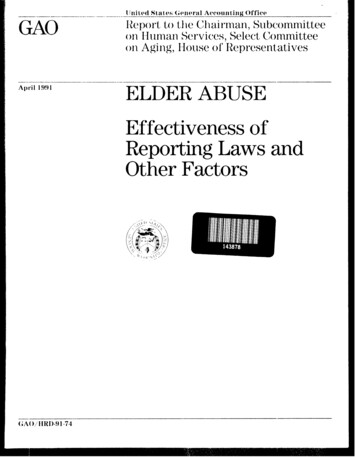
Transcription
ELDER ABUSEEffectiveness ofReporting Laws andOther Factors
GAOunited stamGeneral AcconntingOfficeWashington,D.C.20548Human IbourcesDivisionB-243268April 24,lQQlThe Honorable Thomas J. DowneyChairman, Subcommittee onHuman ServicesSelect Committee on AgingHouse of RepresentativesDear Mr. Chairman:This report responds to your request that we study mandatory and voluntary reporting laws for elder abuse.In discussionswith your office,we agreed to (1) determine whether a comparison of mandatory and voluntary reporting states will indicate which type of law is most effectivein identifying elder abuse victims and (2) assessexpert opinion on theeffectiveness of reporting laws and other factors in identifying,preventing, and treating abuseof the elderly. We also agreed to focusonly on domestic elder abuse,which takes place in private homes andother community settings, as opposedto institutional elder abuse,whichtakes place in institutions such as nursing homes.The term “elder abuse” generally refers to the abuse,neglect, orexploitation of people aged 60 and older. It may include physical, psychological, and sexual abuse;material or financial exploitation; and neglect and self-neglect.’ Elder abuse is widely considered a serious problemthat affects a large but unknown number of older Americans. The precise number of elder abuseincidents in the United States each year isunknown becauseno standard definition of abuseexists and a significant proportion of incidents never comesto public attention. However,various experts estimate that as many as 1.6 to 2.0 million older Americans may be victims of elder abuse each year,2and the number isexpected to increase as the nation’s elderly population continues togrow.To help identify victims of elder abuse,nearly every state has passedlaws concerning the reporting of elder abuseincidents. Mandatory‘Self-neglect, recognized in the Older Americsns Act (42 U.S.C. 3022 (18)) and many state laws as atype of elder abuse, generally means the faihxe to provide for oneself the goods or services necessaryto maintain one’s health or safety.2U.S. Congress, House, Select Committee on Aging, Subcommittee on Health and Long-Term Care,Elder Abuse: A Decade of Shame and Inaction, 1Olst Gong., 2d sess., 1sgO; Toshio Tatara, Summsriesof National Elder Abuse Data: An Exploratory Study of State Statistics Based on a National Survey ofState Adult F’rotective Service and Aging Agencies, National Aging Resource Center on Elder Abuse,Washington, D.C.: Feb. 1990.Page 1GAO/EJRBSl-74 Euler Abuse Reporting Laws
reporting laws require all people or specific categoriesof professionals,such as physicians and social workers, to report known and suspectedincidents to certain authorities. Under voluntary reporting laws, no oneis required to report, but any person may report incidents of elder abuseto the proper officials. As of November 1990,42 states and the Districtof Columbia had adopted mandatory reporting laws for elder abuse;8states-Colorado, Illinois, New Jersey, New York, North Dakota, Pennsylvania, South Dakota, and Wisconsin-had made reportingvoluntarye3Results in BriefMandatory reporting states cannot be meaningfully compared with voluntary reporting states because(1) laws concerning elder abusevarysubstantially from state to state; (2) states differ widely in the procedures they use for collecting caseidentification data; and (3) the numberof elder abuse casesthat states identify is strongly influenced by manyfactors in addition to reporting laws, but data on these other factors arenot available. Therefore, it is not possible to determine whether one typeof reporting law is more effective than the other in identifying casesofelder abuse.Most experts consider reporting laws-whether mandatory or voluntary-much less effective than other factors in maximizing the numberof elder abuse casesidentified, prevented, and treated. A high level ofpublic and professional awarenessis considered the most effectivefactor for identifying elder abusevictims. In-home servicesfor the elderly is considered the most effective factor for both prevention andtreatment of elder abuse.Reporting laws are seenas moderately effective in caseidentification, but few experts seethese laws as effective foreither preventing a first occurrenceof elder abuseor treating substantiated cases.Although it clearly seemsimportant to have somesystem for reportingelder abuse, focusing the debate on the relative effectiveness of mandatory versus voluntary reporting seemsto be of questionable value. Curfindings suggestthat efforts to raise public and professional awareness,improve interagency coordination, and increase the availability of inhome services and respite care have a more significant impact on theeffectiveness of state elder abuseprograms.% New Jersey, voluntary reporting for domestic elder abuse is not prescribed by law; however, thestate operates a voluntary system based on administrative policy.Page 2GAO/HRlMl-74Elder Abuse Reporting Lawa
The Debate OverMandatory andVolun.tary ReportingLawsExperts and policymakers have debated for many years whether statesshould adopt mandatory or voluntary reporting laws. A key issue in thisongoing debate is whether mandatory reporting laws are more effectivein caseidentification than voluntary reporting laws.4Supporters of mandatory reporting believe that it results in a higher number of reportsbecausesomepeople will not report unless required to do so by law.Proponents of voluntary reporting contend that it is equally effective,primarily becausepeople’s reporting is influenced by many factors otherthan reporting laws.The debate over mandatory and voluntary reporting laws has influencedproposed federal legislation concerning elder abuse.A bill (H.R.386) introduced in January 1991 proposes a new program of grants toassist the states in preventing, identifying, and treating elder abuse.Toqualify for financial assistanceunder this bill, however, states would berequired to provide for mandatory reporting of elder abuse.Similar billshave been introduced in every Congresssince 1980, but have neverpassed.In contrast, the 1987 amendmentsto the Older Americans Actcreated a grant program for elder abuseprevention activities that doesnot require states to have a mandatory reporting law to qualify forfunds.” The Congressrecently funded this program for the first time,with a 2.9 million appropriation for fiscal year 1991.ScopeandMethodologyTo determine whether mandatory reporting states can be meaningfullycompared with voluntary reporting states, we reviewed the literature onelder abuse reporting, and examined available information on statereporting laws and caseidentification data. In addition, we interviewedvarious public officials and national experts about the factors that influencethe identification of elder abuse.To assessexpert opinion on the effectiveness of reporting laws andother factors in identification, prevention, and treatment, we surveyed40 state officials. The officials were representatives of state agenciesonaging and adult protective services agencies,the two types of state agencies most closely involved with elder abuseprograms. (Seeapp. I for amore detailed discussion of our scopeand methodology.)4Experts and policymakers also debate whether elder abuse reporting laws (1) make valid assumptlons about the competency of older people, (2) adversely affect client-professional relationships, or(3) trigger investigations that may violate alleged v&iirights to privacy and self-determination.Our review, however, concentrates on the effectiveness of reporting laws only.?itle III, section 371(42 U.S.C. 3030 ).Page 3GAO/HltDSl-74Elder Abuse Reporthg Lnws
We carried out our review from April through December1990 in accordance with generally acceptedgovernment auditing standards.Mandatory andVoluntary ReportingStates Cannot BeMeaningfullyComparedbecauseof significant differences in state laws and data collection practices. Moreover, many factors in addition to reporting laws affect caseidentification, but data on these other factors are not available.Laws addressing elder abuse differ widely from state to state. These differences are important becausethey significantly affect the totalnumber of casesstates identify in a given year. For example, states thatinclude self-neglect in their definition of elder abusemay identify morecasesthan states whose elder abuse definitions do not include self-neglect. Somestates that investigate self-neglect caseshave reported thatthese casesaccount for up to 40 or 50 percent of their caseloads.Inaddition, states that do not guarantee confidentiality for reporters mayreceive fewer reports than states whose laws do include such a provision Someexperts told us that people may not report incidents of elderabuse if they think the alleged victim or perpetrator might find out whothey are.Data collection practices also vary considerably from state to state.Many states cannot provide comparable data on the total number ofcasesidentified. For example, a study of state data for fiscal years 1986to 1988 found that 19 states did not maintain separate statistics for theelderly and other adult victims of abuse;somestates combined reportsof domestic abuse with reports of institutional abuse;and other statescould not distinguish reports that were substantiated through an investigation from reports that were unsubstantiated.6This lack of comparable data prevents a valid comparison of mandatory and voluntaryreporting states.Another reason why a comparison of mandatory and voluntaryreporting states would not be meaningful is becausemany factors, inaddition to reporting laws, play important roles in the identification ofelder abuse cases.Someof these other factors include the level of publicand professional awareness,the procedures for reporting, and the reputations of elder abuse agenciesfor resolving elder abusecases.Peoplemay not report elder abuse if they do not accurately recognizeits signs,6Tatara, Summaries of National Elder Abuse Data.Page 4GAO/HRDSl-74Elder Abuse Reporting Laws
0248208find reporting difficult or time-consuming, or believe that the responsible agenciesdo not resolve these casessuccessfully. The effects ofthese other factors must be accountedfor to determine the independentimpact of mandatory and voluntary reporting laws on caseidentification However, this kind of analysis is currently not possible, primarilybecausedata are unavailable for many of these factors and would bevery difficult to collect.Several FactorsConsidered MoreEffective ThanReporting LawsReporting laws- whether mandatory or voluntary-are not consideredthe most effective factor for identifying, preventing, or treating elderabuse.’ Although over one-third of the 40 state officials we surveyedsaid reporting laws are effective for identification, the factor mentionedmost frequently was a high level of public and professional awareness.The factor mentioned most often for both preventing and treating elderabusewas in-home services for elders; very few respondents saidreporting laws are effective for prevention or treatment.Public and ProfessionalAwareness ConsideredMost -Effective-foridentificationThe factor most often mentioned as effective for caseidentification wasa high level of public and professional awarenessof what elder abuseisand how to report it. This factor was ranked as one of the three mosteffective factors for maximizing the number of casesidentified by 32, or80 percent, of the state officials we surveyed, including 23 who rankedit first (see fig. 1). Public and professional awarenessis critical for caseidentification becauseagenciesrely heavily on the public to find outwhen incidents of elder abusehave occurred. Before people can reportsuch incidents, however, they need to know what elder abuseis andhow reports may be made.‘Our assessment of the relative effectiveness of reporting laws and other factors is baaed on the totalnumber of times survey respondents ranked them as one of the three most effective factors in maximizing the number of cases identified, prevented, or treated.Page 5GAO/HRD-91-74 Elder Abuse Reporthg Laws
Figure 1: Ettectlvenes8 of Nine FactonIn Identifying Elder AbuseNumkr of Responsu322416Factors Con ldomd Effectlvo for ldentlfylng CasesIFrequency Ranked Moat EffectiveFrequency Ranked second Most EffectiveFrequency Ranked Third Most EffectiveNote: Maximum number of responses 40.Source: GAO survey of state agency officials (1990).State efforts to increase awarenessof elder abuse include education andinformation campaigns for the general public, as well as special trainingprograms for certain types of professionals and other people likely tointeract with the elderly. Several respondents said they believe thatpublic and professional awarenessefforts have led to increasesin thenumber of reports received. Several respondents also pointed out thatadequate resourcesare necessaryto conduct prompt and thoroughinvestigations of the increasednumber of reports typically generated bypublic education campaigns.An adult protective servicesdirector said,for example, that local officials in her state resisted putting up postersPage 6GAO/ 91-74Elder Abuse Reporting Lawa
to increase public awarenessbecausethese officials feared receivingmore reports than they could investigate.Reporting laws are also considered effective for identifying elder abuse,although they were mentioned substantially less often than public andprofessional awareness.This factor was ranked among the three mosteffective factors for caseidentification by 16 state officials, including 8who ranked it first. Reporting laws define the responsibilities of government and private citizens in responding to the problem of elder abuse.These laws establish official procedures for making reports, as well as asystem for receiving and investigating those reports. For these reasons,state officials and other experts generally believe it is important for astate to have sometype of reporting law to help identify cases.A secondfactor mentioned by 16 respondents was elder abuse agencies’reputations for resolving casessuccessfully, Peoplewill be more willingto report elder abuse,two respondents said, if they believe doing so willlead to positive outcomes for the victims. The biggest fear of potentialreporters, one state official explained, is that nothing happens afterthey report.Interagency coordination was also ranked by 16 respondents as one ofthe three most effective factors for identifying casesof elder abuse.Interagency coordination is necessarybecause(1) a number of differentstate and local agenciesmay be responsible for making, receiving, andinvestigating elder abusereports and (2) identifying victims of elderabusemay be only one of an agency’smany responsibilities. Forexample, if a social worker from a department on aging suspectsthat anelderly client is being abused,the social worker may need to report theincident to the local adult protective servicesagency. This agency wouldthen screenthe report and, if deemedappropriate, initiate an investigation. If a worker from adult protective servicesmeets resistance intrying to investigate the report, he or she may require the assistanceoflaw enforcement officials. These diverse agenciesneed to establish collaborative and cooperative working relationships, experts say, or elsesomevictims of elder abusemight never be identified.In-Home ServicesConsidered Most Effectivefor PreventionThe factor most often mentioned as effective for preventing a firstoccurrenceof elder abusewas in-home services,such as home healthcare, meals-on-wheels,and homemaker and chore services.Twenty-sixof the state officials we surveyed ranked this factor as one of the threemost effective factors in maximizing the number of casesprevented (seePage 7GAO/HID-91-74 Elder Abuse RqortingImw
B-243266fig. 2). In-home servicesprovide neededassistanceto older people whocannot easily leave their homesor who have difficulty caring for themselves,Without these services,an older person’s health or living environment could deteriorate, leading to sometype of elder abuse,forexample neglect or self-neglect. In-home services are also consideredeffective for prevention becausetrained service providers, who regularly visit older people in their homes,may detect an increased risk ofelder abusethat would otherwise go unnoticed. Additional servicescould then be offered to help prevent elder abusefrom happening.Figure 2: Efl ectiveneas of Eight Factorsin Preventing a First Occurrence 01 ElderAbuse32Numbsr of Responsea2624nFactom Considered Effsctlvs for Preventing CasesFrequency Ranked Most EffectiveFrequency Ranked Second Most EffectiveFrequency Ranked Third Most EffectiveNote: Maximum number of responses 40.Source: GAO survey of state agency officials (1990).Page 8GAO/HRD-91-74 Elder Abuse Reporting Laws
B-248268A high level of public and professional awarenesswas mentioned by 20state officials as one of the three most effective factors for preventingelder abuse.Public and professional awarenessis consideredeffectivefor prevention becausepreventive action can only be taken if high-risksituations are recognizedbefore abuseoccurs; educating people aboutthe causesof elder abuseis one of the objectives of public awarenesscampaigns. In addition, public education programs inform older peopleand their caregivers about the various servicesavailable to help preventelder abuse,such as in-home services and respite care.In-home respite care was also ranked among the three most effectivefactors for prevention by 20 survey respondents.Respite care providestemporary care for a dependent older person, allowing the usualcaregivers a chanceto get out of the home. This kind of service is effective for prevention becauseit reducesthe stress associatedwith caringfor a dependent older person, commonly identified as one of the majorcausesof elder abuse.Experts believe that caregivers are less likely tobecomeabusive if the stress associatedwith caring for a dependentolder person can be temporarily relieved through in-home respite care.Reporting laws were infrequently mentioned as effective for preventingelder abuse:only 6 of the 40 state officials we surveyed rankedreporting laws as one of the three most effective factors for maximizingthe number of casesprevented. One reason why reporting laws were notranked higher is that respondents did not seea direct relationshipbetween these laws and prevention. One respondent, however, suggestedthat reporting laws help to prevent elder abuseindirectly by alertingofficials to high-risk situations.In-Home ServicesConsidered Most Effectivefor TreatmentThe factor most frequently mentioned as effective for treatment was inhome services for elders. This factor was ranked as one of the threemost effective factors for maximizing the number of casestreated by 26state officials, including 10 who ranked it first (see fig. 3). In-home services, such as home health care, meals-on-wheels,and homemaker andchore services,help correct the circumstancesthat lead to elder abuseinitially and prevent it from recurring. In addition, several state officialswe surveyed said that adequate resourcesare crucial for providing thiskind of treatment to elderly victims and their caregivers.Page 9GAO/HRD91-74 Elder Abuse Reporting Laws
Figure 3: Effectlvenera of Eight Factor8In Treattng Elder Abuse32Numbsr of ResponsesFactors Considered Effactivo for Treating CasesI-1 Frequency Ranked Most Effective-Frequency Ranked Second Most EffectiveFrequency Ranked Third Most EffectheNote: Maximum number of responses 40.Source: GAO survey of state agency officials (1990)Interagency coordination was the secondhighest-ranked factor fortreating elder abuse;it was ranked among the three most effective factors by 18 survey respondents.Interagency coordination is essentialbecausetreatment services are often provided by numerous public andprivate agencies,and victims of elder abusemay be only one of theclient groups these agenciesare responsible for serving. If these agenciesdo not develop collaborative and cooperative working relationships,someelder abusevictims and their caregivers may not receive the treatment servicesthey need.The third highest-ranked factor for treating elder abusewas in-homerespite care, mentioned by 17 respondents as one of the three mosteffective factors for maximizing the number of casestreated. In-homePage 10GAO/HRD91-74 Elder Abuse Reporting Laws
B-242288respite care is effective for treatment, experts say, becausecaregiversare more likely to stop mistreating their dependent elderly if the stressassociatedwith caring for them can be temporarily relieved.Reporting laws were seldom mentioned as effective in treating elderabuse:only 6 of the 40 respondents ranked reporting laws among thethree most effective factors for maximizing the number of casestreated.One reason why reporting laws were not ranked higher is that respondents did not seea direct connection between these laws and the treatment of substantiated cases.Someexperts, however, believe that havingreporting laws on the books has helped indirectly by influencing statelegislatures to provide increased resourcesfor treatment services.ConcludingObservationsOn the basis of our review of the literature and discussionswithexperts, we believe that the debate over mandatory and voluntaryreporting laws will produce uncertain answers concerning the relativeeffectiveness of these laws in identifying, preventing, and treating elderabuse.State officials we surveyed agreethat other factors-such aspublic awarenesscampaigns,interagency coordination, and in-home services and respite care- are more important than reporting laws. Thissuggeststhat improvement in elder abuseprograms is more likely toresult from attention to these other factors, rather than from requiring aparticular type of reporting law.-As arranged with your office, unless you publicly announceits contentsearlier, we plan no further distribution of this report until 30 days afterits issue date. At that time, we will send copiesto the Secretary ofHealth and Human Services,the Commissionerof the Administration onAging, and the Directors of state agencieson aging and adult protectiveservices agencies.We will also make copies available to other interestedparties on request.GAO/HRD-91-74 Elder Abuse Reporting LawsPage 11’,’ !
B&42288Pleasecall me on (202) 27645366if you or your staff have any questionsabout this report. Other major contributors are included in appendix II.Sincerely yours,Gregory J. McDonaldAssociate Director, Income Security IssuesPage 12GAO/IXUDBl-74 Elder Abuse Reporting Laws
Page 18GAO/H.RD91-74 Elder Abuse Reporting Laws
ContmtsAppendix IScopeandMethodology16Appendix IIMajor Contributors toThis Report19Bibliography20-TableTable 1.1:GAO Survey of 26 States With the LargestElderly Population (as of July 1,1988)FiguresFigure 1: Effectiveness of Nine Factors in IdentifyingElder AbuseFigure 2: Effectiveness of Eight Factors in Preventing aFirst Occurrenceof Elder AbuseFigure 3: Effectiveness of Eight Factors in Treating ElderAbusePage 14176810GAO/HRD-91-74 Elder Abwe Iteporting Laws; I, ;”
Page 16GAO/HID-91-74 Elder Abuse Reporting Laws
Appendix IScopeand MethodologyWe collected and analyzed information from a variety of sources:Wereviewed the literature on elder abusereporting, including journal articles, state and local demonstration project reports, and studies publishedby national associationson elder abuse.We interviewed federal officialsat the Department of Health and Human Servicesand the Administration on Aging; we also interviewed national experts on elder abuse at theNational Aging ResourceCenter on Elder Abuse, the National Association of State Units on Aging, and the National Committee for the Prevention of Elder Abuse. In addition, we interviewed state and local officialsknowledgeable about elder abuse.Finally, we conducted a telephonesurvey of 40 officials in state agencieson aging and adult protectiveservices agencies-the two types of state organizations most closelyinvolved with elder abuseprograms.For our survey, we initially called officials from state agencieson agingand adult protective services agenciesin the 26 states with the largestpopulations aged 66 and older (seetable 1.1).In 9 of these states, wesurveyed only one person becausethe adult protective servicesprogramis part of the state agency on aging.l In 16 of the 16 remaining states, wesurveyed representatives of both agencies.2In each case,we interviewedeither the agency director or the person whom the director designated asmost qualified to answer our questions on behalf of the organization.‘These states are Arizona, Florida, Illinois, Indiana, Massachusetts, Missouri, Pennsylvania, Waahingtq and Wisconsin.21nNorth Carolina, we interviewed only one official-from the adult protective services agency; stateagency on aging officials declined to participate because they said the adult protective servicesagency has statutory responsibility for elder abuse.Page 16GAO/HRD91-74 Elder Abuse Reporting Laws
Appendix IScope and MethodologyTable 1.1: GAO Survey of 26 States Withthe Largest Elderly Population (as of July1, 1986)Numbers in thousandsPopulation aged 65 and olderStateCaliforniaNew w JersevMassachusettsNorth 155154051349847946444743525,305’aThis number represents 83 percent of the total elderly population in the United States.Source: Statistical Abstract of the United States, 1990, U.S. Department of Commerce, Bureau of theCensus (Washington, DC.: U.S. Government Printing Office, 1990), p. 23.In our survey, we focused on domestic elder abuse,which occurs in private homes and other community settings; we did not address abusethatoccurs in institutions, such as nursing homes.We defined “elder” as aperson aged 60 or older (the definition used in title III of the OlderAmericans Act). We defined “abuse” very broadly to include physicaland psychological abuse,material or financial exploitation, neglect byothers, and self-neglect.Page 17GAO/IXRD-91-74 Elder Abuse Reporting Laws
Appendix IScopeand MethodologyThe survey questions focused on the effectiveness of reporting laws andvarious other factors in the identification, prevention, and treatment ofelder abuse.We defined “identification” as the reporting and officialverification of cases,“prevention” as stopping a first occurrenceofabuse,and “treatment” as efforts intended to correct substantiatedcases.For each of these areas, we read to the respondents a short list offactors consideredimportant in the literature and by experts. Fromthese three lists, we asked the respondentsto name the three factorsthey consider the first, second,and third most effective in maximizingthe number of casesidentified, prevented, and treated. We determinedthe relative effectiveness of all the factors on the basis of the totalnumber of times each factor was ranked as one of the three most effective factors.We also asked our respondents open-endedquestions to elicit any comments they had about the issuescovered in the survey. Their statementsoften helped to explain why they ranked certain factors higher thanothers.Page 18GAO/HID-91-74 Elder Abuse Reporting Lam
Appendix IIMajor Contributorsto This ReportHuman ResourcesDivision,Washin&on, DC.Cynthia A. Bascetta, Assistant Director, (202) 275-0020James C. Musselwhite, Assignment ManagerEric R. Anderson, Evaluator-in-ChargeTimothy W. Silva, EvaluatorDavid P. Alexander, Social ScienceAnalystPage 19GAO/HID-91-74 Elder Abuse Reporting Laws
Bibliography“An Analysis of States Mandatory Reporting Laws on Elder Abuse.”ALLIANCE/Elder Abuse Project. Syracuse,N.Y.: 1983.Bergman, JamesA. “Elder Abuse Reporting Laws: Protection or Paternalism.” Unpublished. Apr. 1982.“Responding to Abuse and Neglect Cases:Protective ServicesVersus Crisis Intervention.” In Elder Abuse: Practice and Policy byRachel Filinson and Stanley R. Ingman, eds. New York, N.Y.: Human SciencesPress,Inc., 1989, pp. 94-103.-*Block, Marilyn R,, and Jan D. Sinnott, eds. The Battered Elder Syndrome: An Exploratory Study. CollegePark, Md.: Nov. 1979.Callahan, JamesJ., Jr. “Elder Abuse: SomeQuestionsfor Policymakers.”The Gerontologist. Vol. 28, No. 4 (1988), pp. 463-68.Clark-Daniels, Carolyn Lea, and others. “Physicians’ and Nurses’Responsesto Abuse of the Elderly: A Comparative Study of TwoSurveys in Alabama.” Journal of Elder Abuse & Neglect. Vol. 1, No. 4(1989), pp. 67-72.Coleman, Nancy, and Naomi Karp. “Recent State and Federal Developments in Protective Servicesand Elder Abuse.” Journal of Elder Abuse&Neglect. Vol. 1, No. 3 (1989), pp. 61-63.A ComDrehensiveAnalvsis of State Policv and Practice Related to ElderAbuse: A Focuson Legislation, Appropriations, Incidence Data and Special Studies. American Public Welfare Association (APWA)/NationalAssociation of State Units on Aging (NASUA) Elder Abuse Project.Washington, D.C.: July 1986.A ComprehensiveAnalysis of State Policy and Practice Related to ElderAbuse: A Focus on Roles and Activities of State-Level Agencies,Interagency Coordination Efforts, Public Education/Information Campaigns.APWA/NASUA Elder Abuse Project. Washington, DC.: Nov. 1986.A ComprehensiveAnalysis of State Policy and Practice Related to ElderAbuse: A Focus on State Reporting Systems.APWA/NASUA ElderAbuse Project. Washington, DC.: Sept. 1986.Page 20GAO/HMb91-74 Elder Abuse lbportingLawm
Crystal, Stephen. “Social Policy and Elder Abuse.” In Elder Abuse: Conflict in the Family by K.A. Pillemer and R.S.Wolf, eds. Dover, Mass.:Auburn House Publishing, 1986, pp. 331-40.“Elder
laws concerning the reporting of elder abuse incidents. Mandatory 'Self-neglect, recognized in the Older Americsns Act (42 U.S.C. 3022 (18)) and many state laws as a type of elder abuse, generally means the faihxe to provide for oneself the goods or services necessary to maintain one's health or safety.
